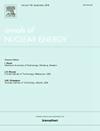Neutronic analysis for withdrawal of TRIGA MARK II reactor control rods using OpenMC program
IF 1.9
3区 工程技术
Q1 NUCLEAR SCIENCE & TECHNOLOGY
引用次数: 0
Abstract
Currently, the TRIGA 2000 Bandung reactor which is a MARK II type has reshuffling some of the fuel elements to maintain its criticality during operation. The reshuffling includes filling and moving fuel which has a different uranium composition for each element. Heterogeneity in the composition of fuel elements has the potential to produce fairly high neutron flux and PPF (Power Peaking Factor) values. This is the main focus that needs to be discussed in this study. The purpose of this study is to conduct a neutronic analysis in the form of calculating the values of k-eff, PPF, neutron flux spectrum, reactions rate, neutron flux distribution, and power density distribution with several control rod withdrawal conditions. Analysis of two types of PPF is also discussed, including APF (Axial Power Peaking Factor) and RPF (Radial Power Peaking Factor). Validation in the form of k-eff and APF parameters of the F7 fuel element has been carried out to see the accuracy of the OpenMC code. The results of the validation of the OpenMC and MCNP neutronic parameters for all control rod withdrawal variations show accurate value agreement with %Δk < 1 %. The results of the k-eff value and excess reactivity indicate that the reactor can operate critically if the control rod withdrawal percentage is >50 %. Increasing the control rod percentage significantly affects the APF and RPF value, which shifts and decreases. At 60 % and 100 % withdrawal, the maximum APF values are 1.332 and 1.245. Meanwhile, the RPF values are 2.042 and 1.898. The withdrawal of control rods has a slight impact on the increase in neutron flux spectrum and the fission-absorption reaction rate in the fuel, particularly at thermal energies. A different condition occurs for the maximum neutron flux in the inner radial ring, which decreases as the control rods are withdrawn. The power density distribution results of the 111 fuel elements show that the reactor core still has heterogeneity. This presents a prospect for future research in designing the TRIGA 2000 Bandung reactor to achieve a more uniform power distribution.
求助全文
约1分钟内获得全文
求助全文
来源期刊

Annals of Nuclear Energy
工程技术-核科学技术
CiteScore
4.30
自引率
21.10%
发文量
632
审稿时长
7.3 months
期刊介绍:
Annals of Nuclear Energy provides an international medium for the communication of original research, ideas and developments in all areas of the field of nuclear energy science and technology. Its scope embraces nuclear fuel reserves, fuel cycles and cost, materials, processing, system and component technology (fission only), design and optimization, direct conversion of nuclear energy sources, environmental control, reactor physics, heat transfer and fluid dynamics, structural analysis, fuel management, future developments, nuclear fuel and safety, nuclear aerosol, neutron physics, computer technology (both software and hardware), risk assessment, radioactive waste disposal and reactor thermal hydraulics. Papers submitted to Annals need to demonstrate a clear link to nuclear power generation/nuclear engineering. Papers which deal with pure nuclear physics, pure health physics, imaging, or attenuation and shielding properties of concretes and various geological materials are not within the scope of the journal. Also, papers that deal with policy or economics are not within the scope of the journal.
 求助内容:
求助内容: 应助结果提醒方式:
应助结果提醒方式:


